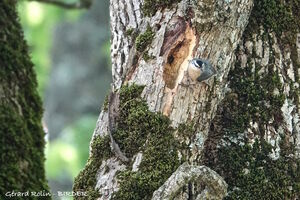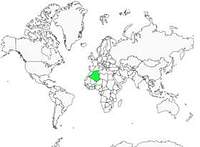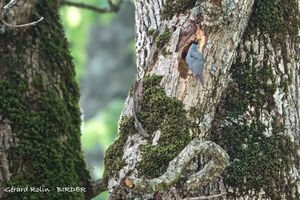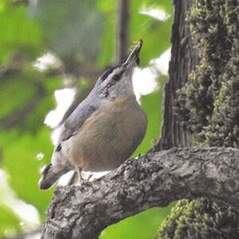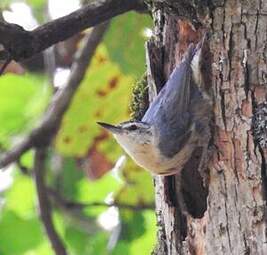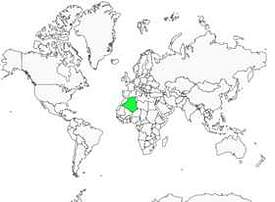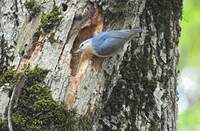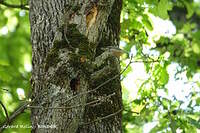Algerian Nuthatch
Sitta ledanti - Sittelle kabyle
Identification
The Algerian Nuthatch can easily be identified by its shape and plumage, which resemble those of the Nuthatch. As it is the only Nuthatch present in the forests of the north-east of Algeria, there is no problem with identification. It is smaller than the Nuthatch, but larger than the Corsican Nuthatch, to which it bears a strong resemblance. Along with the Krüper's Nuthatch (to which it is closely related genetically), they form what used to be called the 'mesogean nuthatch' group, which is spread around the Mediterranean Sea.
The upper parts are a blue-grey colour, like most members of the family. Depending on the light, the age, or sex, grey or blue will predominate. The wing feathers and rectrices are brownish-black, the former with a blue-grey edging and the latter, apart from the middle ones, with a white subterminal mark spreading from the inside to the outside. This can only be seen on a flying bird, thus seeing it in the wild is not easy. The underside is cream with russet, but again, this can vary in different lights. The colour is lighter and creamier on the throat and under the tail feathers, which are uniform. The beak is quite short and somewhat upturned due to a strong gonial angle, while the culmen remains straight. It is two-coloured, blackish at the base and blue-grey above.
There is a sexual dimorphism present, but not very noticeable. The male has more colourful and contrasted plumage. It can mainly be identified by the black at the front of the crown going up to the level of the eyes, clearly separated from the blue which follows.A black band runs along the beak to the top of the ear, including the dark eye. Shorter than in the Common Nuthatch, it is very clear in front of the eye, but less so at the back. This band is highlighted by a clear white eyebrow and contrasts with the pale cheeks. In the female, the black of the crown is less pure, clearly less extended and less well defined, and the eye line less pronounced. The eyebrow is more cream. Note that these plumage characteristics become clear only with wear. The juvenile resembles the female, with even less distinct characteristics, an indistinct band and eyebrow, a crown of the same colour as the mantle, itself paler and less blue. Sexual dimorphism already seems to exist in young birds, of the same order as in the adult, namely a darkened crown to the eye in the young male, and a crown of the same colour as the mantle in the young female, with only a dark point on the forehead.
Subspecific information monotypic species
Foreign names
- Sittelle kabyle,
- Trepador de Kabilia,
- trepadeira-da-argélia,
- Kabylenkleiber,
- atlasz-csuszka,
- Algerijnse Boomklever,
- Picchio muratore della Kabilia,
- kabylnötväcka,
- Kabylspettmeis,
- brhlík dubový,
- brhlík kabylský,
- Kabyler-spætmejse,
- algeriannakkeli,
- pica-soques d'Algèria,
- Barrigða,
- kowalik algierski,
- Alžīrijas dzilnītis,
- alžirski brglez,
- Алжирский поползень,
- アルジェリアゴジュウカラ,
- 阿尔及利亚䴓,
- kabylnötväcka,
- 安哥拉鳾,
Voice song and call
The vocalisations of the Algerian Nuthatch are typical of a Sittidé. It is these vocalisations which allow the bird to be identified first and foremost in its forest habitat. Two distinct cries can be identified. Firstly, the territorial call of the male, which consists of a rather untranslatable rough note, cheee cheee cheee ..., reminiscent of the cry of the Jay and very similar to the equivalent cry of the Krüper's Nuthatch, but harder. This is also an alarm call. The second type of call is more typically Sittidé. It is a succession of high-pitched musical notes which may be translated as Tui Tui Tui Tui ..., or some variation in the same tempo. This is a call used for contact between individuals. The song is a quick succession of nasal or fluty bisyllabic notes, for example vidi vidi vidi vidi ....
Habitat
Two forest habitats are known to host this Algerian Nuthatch. The original habitat, or at least the habitat in which the species was discovered in 1975 in Petite Kabylie on Djebel Babor, is a mountain mixed forest.
The second habitat occupied, discovered later, is the mountain oak forest that covers the north slope of the secondary reliefs of Petite Kabylie. The Algerian Nuthatch is usually found there above 900m, sometimes below, for example from 350m in Guerrouche forest, but this needs to be confirmed, and it goes up to the summits, the highest approaching 1,600m. The climate is milder and the massifs are less irrigated (1,000 to 1,500mm of rain). The stands are composed of cork oak Quercus suber, zen Q. canariensis and afar Q. afares, the latter at a higher altitude than the former and most often in a mixture. Here too, the Algerian Nuthatch finds its optimum in mixed oak forests.
Behaviour character trait
The discovery of the Algerian Nuthatch species is recent (1975). The forests it inhabits are inaccessible to ornithologists due to the political and military situation of the country.
For example, one cannot currently travel to Algeria with binoculars and spotting scopes, classified as sensitive equipment. And the available equipment on site is not performing. So birdwatching is limited. All of this means that the biology and ecology of the Algerian Nuthatch are not yet well known. Some nest observations have been done which have enabled precision on certain parameters of the reproduction, but the food is still need to be studied in detail.The Algerian Nuthatch is a sedentary species. Settleability is allowed by the passage from an essentially insectivorous regime in the summer to a mainly granivorous regime in winter. The species is monogamous. The territorial couples share the forested space during the breeding season. In the bad season, the birds can join multi-species mobile groups, mostly made up of tits, called rounds, which exploit resources in a rational way. It is unknown whether the species form reserves for the winter.
During a recent observation session on May 9th, we were able to observe a male regularly coming to the hole of the cavity where the female was and dropping off what it had in its beak. At that date, it is likely that it is prey intended for the female in incubation.
Flight
Dietfeeding habits
The Algerian Nuthatch feeds like other nuthatches or even tits, looking for food acrobatically, for example head down under the branches, helped by its strong legs.
Unlike its cousin, the Willow Tit, it seems to go down to the ground rarely. It prefers to explore crevices in tree bark, branches covered in moss and lichen, foliage in the summer, conifer cones, etc.Its diet is mostly insectivorous in spring and summer, searching for insects and their larvae, arachnids and other small invertebrates. It also feeds its young and young tender seeds. In bad weather, the diet becomes mainly granivorous but still includes some animal matter, for example the resistant forms of insects that it can unearth on trunks and branches. A detailed analysis of the diet is still to be done.
Reproduction nesting
Algerian Nuthatches are best known for their biology and nesting habits. Nests can take place from April to July and at the higher altitudes, they may nest later.
They nest in the cavities of dead trees or branches; these can be found between 3 to 15 meters in height and average at 8 to 10 meters. In Djebel Babor, cedar trees are usually chosen as the nest. Elsewhere, they use a formerly used Great Spotted Woodpecker cavity. The wing hole size is usually not modified, even though they can do it, and if they chose a natural cavity, they sometimes mason the entrance with mud and dead wood. After reproduction, a nest revealed its composition which consists of wood chips, vegetal elements, grass leaves, moss, and even synthetic fibers accompanied by assorted feathers and hairs, including boar bristles.Recent monitoring of nests in Guerrouche Forest in Taza National Park has given details on the reproductive biology of the Algerian Nuthatch. Eggs were laid between March 24th and April 30th and a clutch size contains 5 to 6 white eggs with reddish to purplish spots. The female incubates them for a period of 14 to 15 (17) days. The male is more active when it comes to feeding the young at the nest, especially near the end of the breeding cycle. The stay in the nest was estimated to be 3 weeks.Emancipation would then follow very quickly, less than a week. The hatching success is high (92.5%). The average number of chicks at fledging is 4.6 young per breeding pair. Losses are mainly due to predation from the Eurasian Nuthatch.
Geographic range
The Algerian Nuthatch is an endemic species of some forests in the northeast of Algeria, in the wilaya of Jijel, where it was forTuitously discovered in 1975 by a Belgian ornithologist forester, Jean-Paul Ledant. Jacques Vieilliard, who described the type, gave it its specific name of ledanti in recognition. The discovery was made in the forest summit of Djebel Babor, where it was believed for over 10 years that it was confined. Research since the late 1980s has shown that it is fortunately more widespread than initially imagined. This is how it was discovered in three other forest massifs of different composition and at lower altitudes (see above), the forests of Tamentout, Guerrouche and Djimla. It was in this last massif that I had the chance to observe it on 9 May 2018.
Threats - protection
IUCN conservation status
concern
in the Wild
threatened
evaluated
The Algerian Nuthatch is a threatened species. Already due to its limited and fragmented distribution area (15,000 ha at most, with part of it not being favourable), there is a looming threat. But the biggest danger comes from the negative evolution of the forest habitats. Of course, climate changes are bound to have an influence, but it's mostly human pressure that poses the biggest danger. The Algerian state does not seem to be aware of the importance of protecting this endemic species, or it has other priorities. During the Black Years, this region was known for hosting rebel forces and military presence is still very much in effect. This is the case in the Guerrouche forest, which, even though it is part of a national park, the military has built a road, dug a trench for water supply to the camp at the summit and has cleared the view by deforesting without any respect for the forest environment or regulation and protective measures. Furthermore, the Sittelle-occupied massifs are under pressure from overgrazing by domestic animals which prevents natural forest regeneration. Illegal wood cutting is also a problem as it opens up the environment, reducing biomass, particularly deadwood, which makes the forest less favourable for the Sittelle. As if all this wasn't enough, there is currently a project to transform the Bouafroune forest in Djimla, the smallest of the four occupied massifs, into a recreational forest and it is under the supervision of the forestry services, who apparently do not understand all the implications. And yet, very little needs to be done to make the Algerian Nuthatch a national symbol of nature protection and to give signs of goodwill to international authorities.But the country is not there yet, it lives in a bubble that risks making a lot of noise when it bursts. It would be beneficial to help the Algerian conservation associations to protect their heritage. But this could be seen in a poor light by the authorities.
Recent studies show population densities of Algerian Nuthatch lower than those previously recorded. For example, in the Guerrouche forest, a density between 1 and 2 couples per 10 ha was noted in 2016-17, compared to 2 to 3.25 couples/10 ha at the beginning of the 90s. It would be interesting to know what the current density is in the Babor where it had been estimated (overestimated?) at 4 c/10 ha about 30 years ago. The maintenance of the species in its strongholds is therefore far from guaranteed.
Sources of information
- IOC World Bird List (v15.1), Gill, F and D Donsker (Eds). 2025-12-07.
- Oiseaux d'Algérie, Isenmann P. Moali A.
- HBW Alive,
- Avibase, Lepage Denis
- xeno-canto, Sharing bird sounds from around the world,
Other sources of interest
 Specification sheet created on
27/07/2023 by Jean François
Specification sheet created on
27/07/2023 by Jean FrançoisTranslation by AI Oiseaux.net
© 1996-2025 Oiseaux.net
- Accipitriformes
- Aegotheliformes
- Anseriformes
- Apodiformes
- Apterygiformes
- Bucerotiformes
- Caprimulgiformes
- Cariamiformes
- Casuariiformes
- Charadriiformes
- Ciconiiformes
- Coliiformes
- Columbiformes
- Coraciiformes
- Cuculiformes
- Eurypygiformes
- Falconiformes
- Galliformes
- Gaviiformes
- Gruiformes
- Leptosomiformes
- Mesitornithiformes
- Musophagiformes
- Nyctibiiformes
- Opisthocomiformes
- Otidiformes
- Passeriformes
- Pelecaniformes
- Phaethontiformes
- Phoenicopteriformes
- Piciformes
- Podargiformes
- Podicipediformes
- Procellariiformes
- Psittaciformes
- Pterocliformes
- Rheiformes
- Sphenisciformes
- Steatornithiformes
- Strigiformes
- Struthioniformes
- Suliformes
- Tinamiformes
- Trogoniformes

